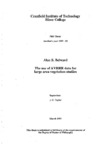JavaScript is disabled for your browser. Some features of this site may not work without it.
| dc.contributor.author | Belward, Alan S. | |
| dc.date.accessioned | 2023-01-05T11:41:23Z | |
| dc.date.available | 2023-01-05T11:41:23Z | |
| dc.date.issued | 1993-03 | |
| dc.identifier.uri | https://dspace.lib.cranfield.ac.uk/handle/1826/18853 | |
| dc.description.abstract | This thesis compares the attributes and limitations of the various Advanced Very High Resolution Radiometer (AVHRR) data types for large area vegetation studies in the context of global change research. In chapter 1, some of the major scientific issues customarily associated with the Global Change concept are outlined, and the specific role of vegetation dynamics in the earth's energy, hydrological and biogeochemical cycles is discussed. Deficiencies in currently available global vegetation data sets and the role of remote sensing as a new source of information are reviewed. This review is supplemented by detailed discussion of the spectral properties of vegetation, soil and water in chapter 2. In chapter 3 the Normalised Difference Vegetation Index (NDVI) and the Perpendicular Vegetation Index (PVI) from 1 km resolution AVHRR High Resolution Picture Transmission (HRPT) data are compared as a means of providing biomass estimates for large geographical areas. The PVI provides better measures of biomass than NDVI, particularly where cover is sparse. Caution in the use of NDVI is recommended. Problems of accurate ground location because of the AVHRR's coarse resolution are highlighted. High resolution (80 m) satellite imagery from the Landsat Multi Spectral Scanner (MSS) is shown to be an effective intermediate step. Comparison with MSS also shows the effect of landscape structure on areal estimates of vegetation cover from the AVHRR HRPT. In chapter 4, MSS and HRPT comparisons show that sensor-induced spatial autocorrelation in AVHRR HRPT data can limit the use of these data for the identification of spatial structure and pattern at full resolution. The same limitation on the use of full resolution data is also found to apply to the spatially sampled AVHRR Global Area Coverage (GAC) archives. In this case local variance induced by sampling in GAC data generation is thought to be the cause. In chapter 5 the structural analysis is extended across a range of resolutions. Sampling artefacts are found for all West African ecosystems at full GAC resolution (4 km), though at coarse resolutions spatial patterns observed with the GAC and the unsampled AVHRR HRPT are very similar. Differences between the two are most pronounced where landscape features are either points or lines. A resolution of 12 km is found to suppress the negative effects of the sampling for all West African ecosystems. At resolutions coarser than 12 km, the GAC data are just as good a measure of landscape structure as the unsampled data. The relevance of these coarse measurement scales to global change research is discussed. Chapter 6 shows that transitions across major ecological zones can be detected at resolutions coarser than 12 km, though the agreement between the sampled and unsampled AVHRR changes both with geographical location and time. This is particularly so for ecosystems affected by fire. Fire is increasingly recognised as a key factor in both the study of global vegetation dynamics directly, and for global change research. This is the focus of chapter 7. Problems relating to the poor sensitivity of the AVHRR's middle-infrared and thermal channels are identified and resolved. The GAC sampling method is shown to affect the sensitivity of these data for fire detection in relation to ecosystem and season. Regional stratification is highlighted as a means of improving fire analysis over large areas, improving land cover classification, and helping in the definition of new cover classes (particularly at continental and global scales) Finally, the results of the previous chapters are discussed with reference to the existing and planned processed AVHRR data archives. The importance of the 12 km limit with reference to the GAC archives is stressed, the need for circumspection in the use of NDVI reiterated, particularly with reference to the derivation of physical measurements from AVHRR, and the requirement for new synergistic approaches to the use of AVHRR with other data emphasised. | en_UK |
| dc.language.iso | en | en_UK |
| dc.rights | © Cranfield University, 2015. All rights reserved. No part of this publication may be reproduced without the written permission of the copyright holder. | |
| dc.title | The use of AVHRR data for large area vegetation studies | en_UK |
| dc.type | Thesis | en_UK |
| dc.description.coursename | PhD | en_UK |
